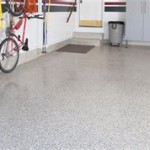Best Way to Paint a Concrete Garage Floor Black and White
Painting a concrete garage floor in a black and white scheme can dramatically improve its appearance, adding a touch of style and potentially increasing its durability. This project, while seemingly simple, requires careful planning and execution to ensure a long-lasting and aesthetically pleasing result. The success of the paint job hinges on proper surface preparation, the selection of appropriate materials, and the application of the chosen paint system. A lack of attention to any of these elements can lead to premature failure of the coating, resulting in chipping, peeling, and the need for costly repairs.
This article outlines the best practices for painting a concrete garage floor in a black and white design, focusing on the key steps necessary for achieving a professional-looking finish. The information provided is targeted towards both homeowners and professionals seeking comprehensive guidance on this popular flooring project. Understanding the underlying principles of concrete preparation and paint application is crucial for ensuring the longevity and visual appeal of the finished floor.
Surface Preparation: The Foundation for a Successful Paint Job
The most critical step in painting any concrete surface is proper surface preparation. This encompasses cleaning, repairing, and profiling the concrete to ensure optimal adhesion of the paint or coating. Neglecting this step will invariably lead to coating failure, regardless of the quality of the paint used. The concrete must be clean, dry, and slightly porous to allow the paint to properly bond.
The initial cleaning process should involve removing any existing coatings, dirt, oil, grease, and other contaminants. This can be achieved through a combination of methods, including scraping, grinding, and chemical cleaning. For oil and grease stains, a degreaser specifically formulated for concrete is recommended. Apply the degreaser according to the manufacturer's instructions, allowing sufficient dwell time for it to break down the contaminants. Thoroughly rinse the surface with clean water to remove any remaining residue.
After cleaning, inspect the floor for cracks, holes, and other imperfections. These should be repaired using a concrete patching compound specifically designed for this purpose. Follow the manufacturer's instructions for mixing and applying the patching compound. Ensure the compound is fully cured before proceeding to the next step. Larger cracks may require the use of a more robust repair mortar or epoxy-based crack filler.
Profiling the concrete surface is essential for promoting adhesion. This involves creating a slightly rough texture that allows the paint to mechanically bond to the concrete. The most common method for profiling concrete is acid etching. This involves applying a diluted solution of muriatic acid to the concrete surface. Always wear appropriate safety gear, including gloves, eye protection, and a respirator, when working with muriatic acid. Follow the manufacturer's instructions for dilution and application. After etching, thoroughly rinse the surface with clean water and allow it to dry completely before proceeding.
An alternative to acid etching is mechanical grinding. This involves using a concrete grinder with diamond grinding pads to create a profile. Mechanical grinding is a more controlled method than acid etching and can provide a more consistent profile across the entire surface. However, it requires specialized equipment and can generate a significant amount of dust. Dust control measures, such as using a vacuum system attached to the grinder, are essential when using this method.
Regardless of the profiling method used, it is crucial to verify that the concrete is sufficiently porous before applying the paint. A simple test involves sprinkling water on the surface. If the water beads up, the concrete is not porous enough and additional profiling is required. If the water absorbs readily into the concrete, it is ready for painting.
Selecting the Right Paint and Primer for a Black and White Design
Choosing the appropriate paint system is crucial for achieving a long-lasting and visually appealing black and white concrete floor. The paint should be specifically formulated for concrete floors and resistant to abrasion, chemicals, and moisture. There are two primary types of paint commonly used for concrete floors: epoxy-based paints and acrylic latex paints.
Epoxy-based paints are known for their superior durability and resistance to chemicals and abrasion. They form a hard, durable coating that can withstand heavy traffic and exposure to automotive fluids. Epoxy paints are typically two-part systems that require mixing before application. They have a limited pot life and can be more challenging to apply than acrylic latex paints. However, the benefits in terms of durability often outweigh the added complexity.
Acrylic latex paints are easier to apply than epoxy paints and are typically less expensive. They are water-based and have low VOC (volatile organic compound) content, making them a more environmentally friendly option. Acrylic latex paints are less durable than epoxy paints and may not be suitable for areas with heavy traffic or exposure to harsh chemicals. However, they can provide a satisfactory finish for residential garages with moderate use.
Before applying the paint, it is essential to prime the concrete surface. A primer serves several purposes, including improving adhesion, sealing the concrete, and providing a uniform base for the paint. Use a primer specifically formulated for concrete floors. Epoxy primers are typically recommended for use with epoxy paints, while acrylic latex primers are suitable for use with acrylic latex paints. Apply the primer according to the manufacturer's instructions, ensuring complete and even coverage.
For a black and white design, select high-quality paints in both colors. Consider using a true black for maximum contrast and a bright, clean white for a crisp and modern look. Be sure to purchase enough paint to apply at least two coats of each color. It is always better to have too much paint than not enough.
When selecting a paint system, consider the intended use of the garage floor. If the garage will be used for parking vehicles, performing automotive repairs, or storing heavy equipment, an epoxy-based paint is the preferred choice. If the garage will primarily be used for storage or as a recreational space, an acrylic latex paint may be sufficient.
Applying the Paint and Achieving the Desired Pattern
Once the surface is properly prepared and the appropriate paint system has been selected, the next step is to apply the paint and create the desired black and white pattern. There are several ways to achieve a black and white design on a concrete garage floor, including checkerboard patterns, stripes, geometric designs, and custom layouts.
Before beginning the painting process, ensure the garage is well-ventilated and protected from the elements. Cover any surrounding surfaces that you do not want to paint with drop cloths or plastic sheeting. Gather all necessary painting tools, including rollers, brushes, paint trays, painter's tape, and measuring tools.
If you are creating a checkerboard pattern, start by measuring the garage floor and determining the size of the squares. Use painter's tape to mask off the squares that will be painted black. Apply the first coat of black paint, ensuring complete and even coverage. Allow the paint to dry completely according to the manufacturer's instructions before applying the second coat.
After the black paint has dried, carefully remove the painter's tape. Mask off the squares that will be painted white, ensuring that the tape is aligned with the edges of the black squares. Apply the first coat of white paint, ensuring complete and even coverage. Allow the paint to dry completely before applying the second coat.
For stripes or other geometric designs, use painter's tape to mask off the desired pattern. Ensure the tape is applied firmly to the concrete surface to prevent paint from bleeding underneath. Apply the paint in thin, even coats, allowing each coat to dry completely before applying the next.
When applying multiple coats of paint, it is important to allow each coat to dry completely before applying the next. This will prevent the paint from peeling or blistering. Follow the manufacturer's instructions for drying times. In general, it is best to wait at least 24 hours between coats.
After all the paint has been applied and has fully cured, consider applying a clear coat sealant. A sealant will provide additional protection against abrasion, chemicals, and moisture. Choose a sealant specifically formulated for concrete floors and apply it according to the manufacturer's instructions.
Proper maintenance is crucial for preserving the appearance and durability of the painted concrete floor. Regularly sweep or vacuum the floor to remove dirt and debris. Clean spills immediately to prevent staining. Avoid using harsh chemicals or abrasive cleaners, as these can damage the paint. By following these guidelines, you can ensure that your black and white concrete garage floor remains beautiful and functional for years to come.

How To Your Garage Floor Using The Rust Oleum Kit From

Types Of Paints And Stains For Concrete Floors The Home Depot

How To Paint Garage Floors With 1 Part Within The Grove

Diy Garage Paint Rustoleum Rock Solid

How To Make Metallic Floor Gunmetal And Slate Colors A Step By Guide Real Project

Graniflex Garage Floor Tailored Concrete Coatings Boyce Va

The Best Flake Patio Floor

Before And After Painted Concrete Patio Thistlewood Farm

Slate Grey Garage Floor Paint Project Regal Paints

6009 Floor Coating Industrial Commercial Low Temp 35 F 100 Solids Quick Cure
Related Posts








